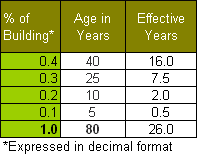Depreciation
Depreciation of buildings is based either on physical deterioration and obsolescence.
Physical Deterioration
Physical deterioration is a loss in value the property due to normal aging and deterioration. Examples of this are:
wear and tear from normal use or from weather
negligent care or lack of maintenance
damage from dry rot, pests, etc.
Obsolescence
Obsolescence is divided into functional obsolescence and economic obsolescence.
Functional obsolescence is a loss in value of the property due to any sub-standard improvements made to it such as:
poor design and an inefficient floor plan
lack of modern facilities
Economic obsolescence is caused by conditions outside the property such as economic changes, legal restrictions and so forth. Examples of this are:
proximity to negative environmental influences
zoning restrictions
adverse supply and demand forces
Depreciation is either curable or incurable. Curable depreciation is a loss of value that can be corrected at a cost less than the increase in property value that would result if it such a correction was undertaken. Incurable depreciation either cannot be corrected or would cost more than any appreciation
of property value. Loss in value due to physical deterioration can usually be controlled by proper usage and maintenance. Losses due to functional obsolescence are less likely to be curable. Losses in value due to economic obsolescence are rarely curable.
Depreciation rates are calculated on physical factors which affect the value of a property. However, it should discard maintenance costs and equally weight properties that experience economic obsolescence within a particular location. The rate of physical depreciation is based on the age of the property and the quality of the construction. When the overall quality of an improvement is low, normal physical deterioration is more rapid than for good construction. Depreciation must take into consideration any modernisations done to the property during its lifetime. The replacement cost must ascertained for each part of the building and then either an effective age or a weighted age assigned to the entire building.
Effective Age
This applies when additions of significantly differing level of quality have been made to building over time. This create a more heterogeneous building having different ages assigned to each of its components. The effective age is calculated by taking the percentage of the modernisations in relation to the whole.
For example:
40% of a building is 40 years old, 30% is 25 years old, 20% is 10 years old and 10% is 5 years old.

The effective age of the building is 26 years.
Weighted Age
The weighted age differs from the effective age in that it is used when the quality of construction is the same for both the original building and the addition(s). The age is weighted according to the percentage attributable to the construction date for each addition.
For example:
10,000 square foot of a building was constructed in 1990. An addition was built in 2000 of equal quality. The addition is 1,000 square metres. The total square metres is therefore 11,000.

The weighted age of the building is therefore rounded off to 1991.
If a building over time has different ages to its part of which some differ in quality and others do not then the effective age of the modernised portions is calculated first, then a weighted age of the entire improvement is calculated.
Calculating Depreciation
If a building costing $120,000 with the land valued at $20,000 was expected to last 50 years, then the annual depreciation would be calculated as:
Value of Building = Property Price - Land Price = $120,000 - $20,000 = $100,000
Annual Depreciation = Value of Building / Expected Lifetime of Building = $100,000 / 50 = $2,000.
Note that there would be fluctuation in the above figure according to whether effective age or weighted age was used in calculating the lifespan of the building.
